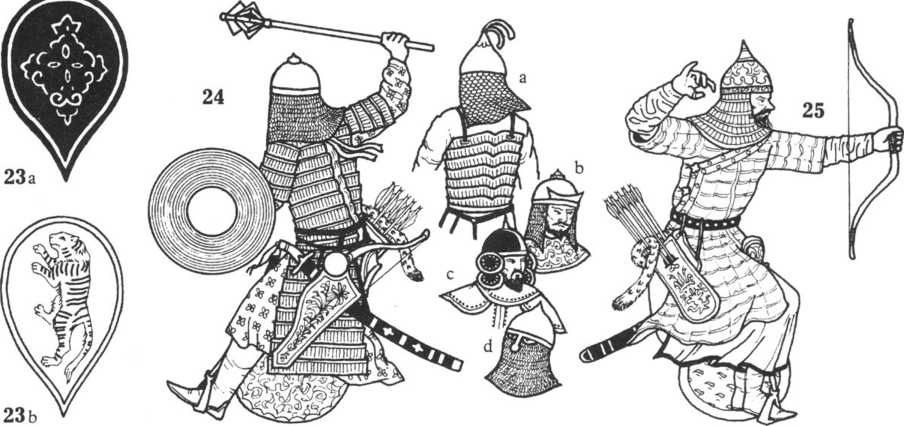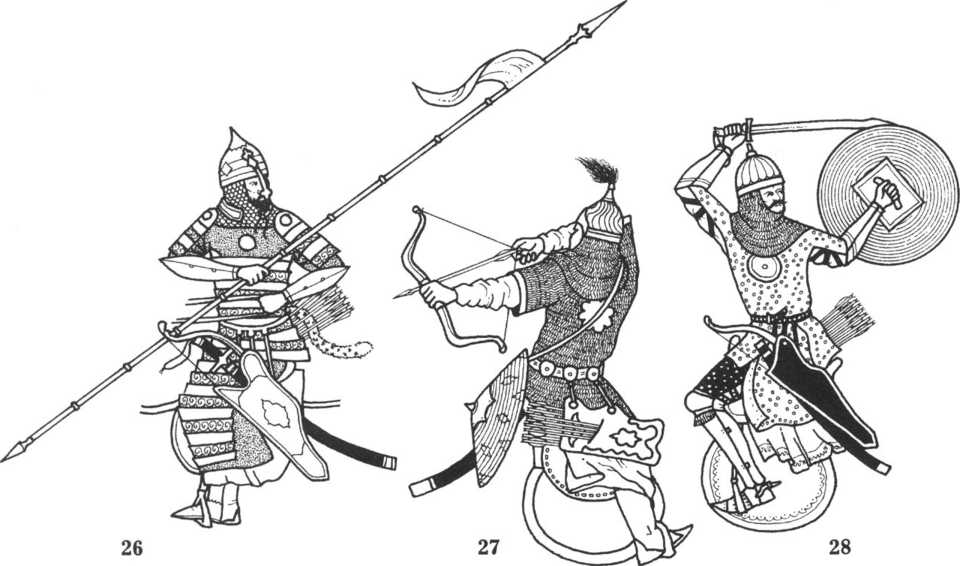This Timurid figure is probably typical of the better-equipped elements of Tamerlane’s armies. According to Sheref ad-Din, in a review prior to the campaign of 1390-91 each Timurid warrior had a lance, sword.


Dagger, mace, lasso (kemend)y a buckler covered in crocodile hide, and a tiger-skin saddle-cloth on his horse, elsewhere mentioning their principal equipment as ‘sword, mace, lasso and bow’, the last item an obvious omission from his first list since we are told in other sources that each Timurid was expected to provide himself with at least a bow, quiver, 30 arrows, and a buckler. He also wrote of ‘maces, iron armour for the horses, all the coats-of-mail, the swords, the bows and arrows, which were distributed to his army’ by Tamerlane, referring several times to ‘fully-armoured cavalry covered in coats-of-mail’, doubtless much like the figure depicted. That mail corselets remained in use alongside laminated and lamellar corselets is clear from contemporary pictures, but outside of central and southern Persia and Transoxiana they were uncommon until the 15th century, when the use of mail underwent a revival throughout Persia (see, for example, figure 32). Under Mongol influence the mail corselet had been adapted into a sort of wrap-round Tartar-style coat, and it is possibly just such a corselet that is worn by this figure.
Drawing on the accounts of eye-witnesses, Bertrando di Mignanelli (a contemporary who lived in Damascus, to which he returned in 1402 after the Timurid sack of the city) reported that Tamerlane ‘did not have warriors with lances because they did not know [how] to use lances. They had only swords and bows’. Since we know from Sheref ad-Din’s chronicle that Timurid equipment did include lances, we should probably interpret this statement as an indication that in action archers far outnumbered lancers. Mignanelli adds too that ‘in place of corselet and breast-plates they always carried large shields’, the implication therefore being that they were all unarmoured — which is not true either. The shield referred to is probably either the leather-covered toure or the iron-covered tcheper (Persian seper), whereas that carried by this figure is the light but arrow-proof cane khalkha. This was probably introduced into Iran by the Mongols in the 13th century, but it is not clearly shown in illustrations until the mid-14th century (though Raschid al-Din’s pictures may indeed depict such shields since they are shown patterned on the inside as well as the outside). It was circular and convex with a large iron boss, and was constructed of cane interwoven with coloured silk or wool to give the bright, geometric patterns evident in many contemporary ms. miniatures as well as on surviving 15th-16th century examples; ‘worked with silk or thread’ is how Contarini described those of the White Sheep Turks in 1475. In addition it was fabric-lined and had a leather cushion behind the boss, and a leather grip. This type of shield became known as a kalkan, the name under which it remained in use in Persia and Turkey up until the 18th century.
Finlay credits Tamerlane with the introduction of uniforms into his army, writing that it ‘was one of the first... in which the various bodies of men were distinguished by the colours of their uniforms’, though he does not cite a source for this dubious piece of information.




 World History
World History









